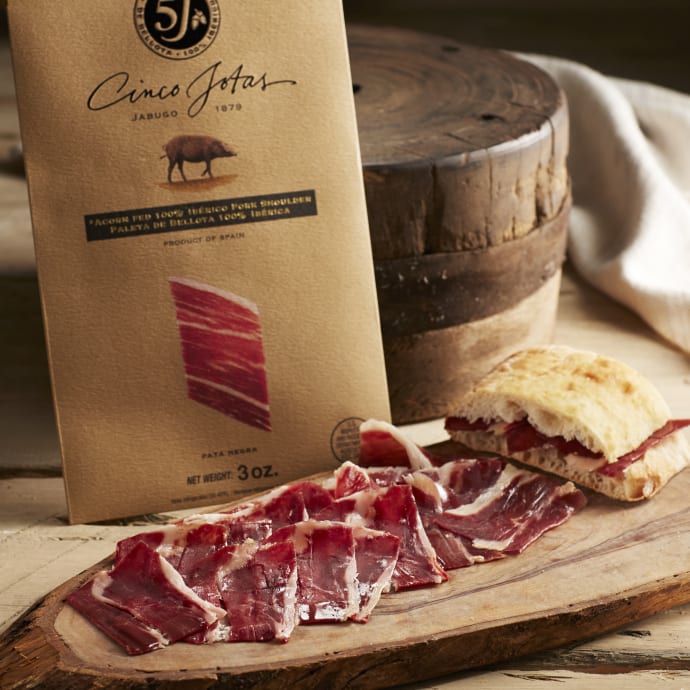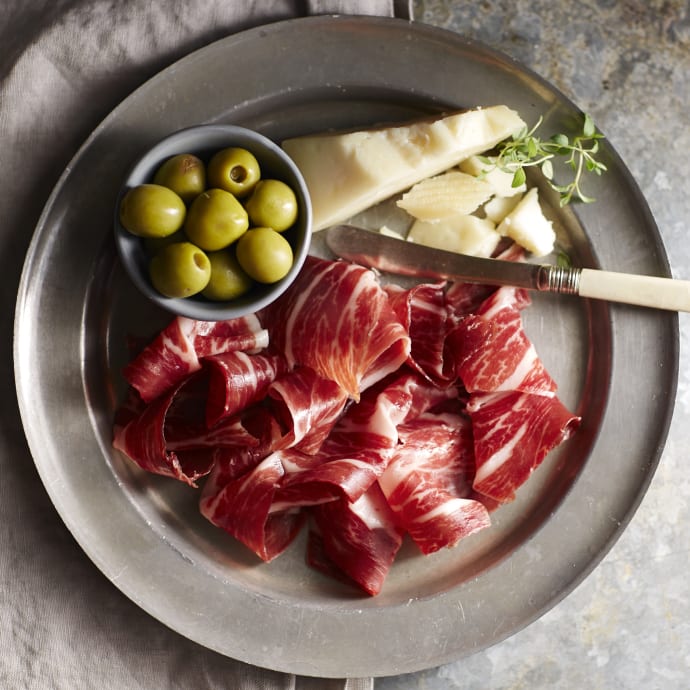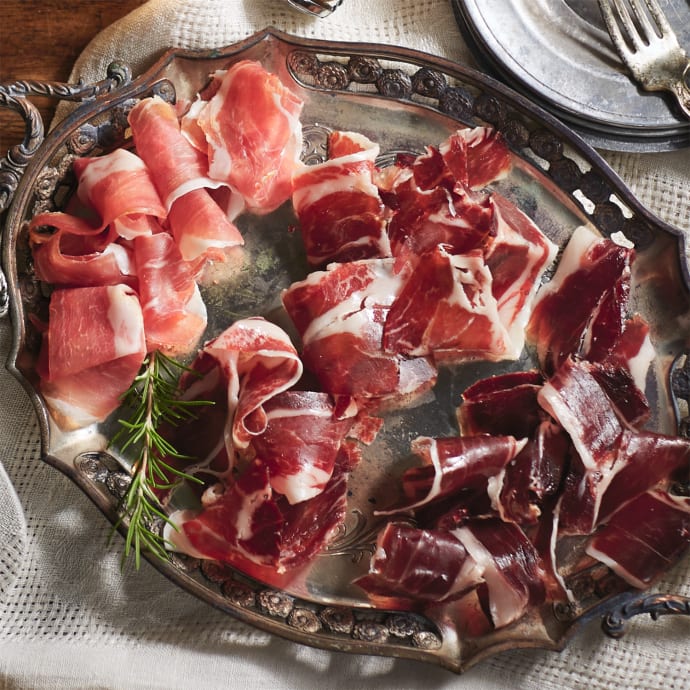
It's Hog Heaven for Pork Lovers
Los Angeles Times
-
October 7, 2010
Jabugo ham coming to the U.S.
Janet Mendel, Special to the Los Angeles Times
Reporting from Jabugo, Andalusia, Spain —
Walking into the central plaza of the small town of Jabugo, you breathe in the aroma of ibérico ham, a sweet-nutty smell so intense it's as if it emanates from the very walls of the houses. This is the source — where ibérico pigs roam through forests of wild oak and scrabble for acorns and where their meat is converted into what many have declared the best ham in the world.
Jabugo, a town nestled in the Sierra de Aracena in southwestern Andalusia, is a name with almost mythic meaning, far out of proportion to the town's size. That's because Jabugo is synonymous with great ham. In a region where every little town seems to have a few butcher shops selling ibérico ham, those from Jabugo stand out. And for the first time, that ham will be available in the United States before the end of the year.
The town is famous for its hams primarily because of the Sánchez Romero Carvajal company, established there in 1879 and now owned by the multinational Osborne Group, makers of fine sherry. The company's hams with the 5J or "Cinco Jotas" label will be available in the United States. The first to arrive probably will be paletas, or shoulder hams from the front legs, because they require a shorter curing period than hams from the rear legs. Regular hams will follow, and the anticipation is growing already.
Ibérico pigs from outside Jabugo were first imported into the United States in 2008, all from the slaughterhouse and curing sheds of Fermin, still the only Spanish company to meet U.S. regulations for meat slaughtering. Now Sánchez Romero Carvajal is partnering with Fermin so that the prestigious Jabugo hams with the 5J brand can be processed through that plant.
Ham lovers quickly snatched up those first ibéricos despite starting prices of more than $1,400 for a 16-pound whole, bone-in ham. The first Jabugo hams will go even higher. One website already advertises a pre-order special of $1,795 for a 5J ham.
Ibérico designates a breed of pig — more about that later. The next important bit of label lingo is bellota, which means "acorn," and it is applied only to hams made from free-range ibérico pigs that were fattened on acorns. Ibérico bellota hams are the crème de la crème, and those from Jabugo are the most treasured of all.
Ibérico-breed pigs, descended from the wild boar that once roamed Mediterranean lands, are the color of the dark stones that are stacked into low walls dividing up pastures. Many — but not all — have black hoofs, thus the popular name, pata negra, or "black foot." They are built like barrels on slim legs. Big ears tip forward like a baseball cap to shade their eyes from fierce sun. They have long snouts, the better for rooting, and slim legs and ankles, the better for foraging over distances.
What distinguishes this breed from regular porkers (such as Large White, Landrace and Duroc) is that they are very slow to mature, never reaching the size of hogs destined to be pork chops. The ibérico breed, adapted to its habitat, has the unusual characteristic of storing fat marbled within the muscle, rather than wrapped around the outside. This makes it less profitable as a meat producer but makes for superior ham, as the fat is essential to its flavor. The breed might have disappeared had it not been so well adapted to its rustic habitat, providing the people of the region a sustainable rural culture based around the pig.
The dehesa, where the ibérico originates, is a unique ecosystem of rolling meadowland interspersed with stands of wild holm and cork oak that exists in the western reaches of Spain. From October to February — the fattening period called the montanera — the pigs range freely through the dehesa, feeding on fallen acorns, grass, roots, bulbs, herbs. Each hog eats about 18 pounds of acorns every day, doubling its weight during the three- to four-month period before slaughter. A pig needs 15 pounds of acorns to gain 1 pound of weight.
The pigs are able to crack the acorns, discarding the shells, to get at the kernel. The acorns are rich in oleic acid, the same found in olive oil, which makes the hams high in monounsaturated fat. That's why acorn-fattened ibérico pigs are sometimes called an "olive tree on four legs."
At the end of the montanera, when the pigs reach optimum weight of 350 to 400 pounds at 12 to 18 months of age, they are trucked to a matadero, or slaughterhouse and processing plant.
Butchers carve off the hams (hind legs) and paletas (front legs), both of which are cured. They separate enormous slabs of fat, which will be melted down to lard. The belly bacon, panceta, is salted down for keeping. Workers separate other parts to be sold as fresh meat or be ground up for sausage. (Ibérico sausages also are available in the U.S.)
The hams are then sent to expert perfiladores, men who sculpt the hams, removing skin and all but about 1 inch of fat covering. Hams are incised with a long V, while paletas are marked with a U. Hoofs are kept intact, except for those being exported to the United States.
Next, the hams and paletas are packed, one by one, in sea salt (with a very small amount of nitrate and nitrite, used in almost all hams and sausages, to prevent bacterial growth and oxidation) where they stay 10 to 12 days, depending on their weight.
The hams then are brushed free of salt and washed in clear water. They spend about 45 days in a cold locker, where the temperature is very gradually raised and the humidity lowered. This controlled stabilization period allows the hams to be processed with less time in salt than in bygone days, when the drying process was dependent on the seasonal change from winter to spring weather.
Then the hams are hung, one by one, in a secadero, or drying hall, situated high in the eaves of the processing plants. Slatted shutters keep out the sun and let in air. Hams hang there throughout the summer, "sweating" during hot weather as the unsaturated fat liquefies slightly, bathing the meat in the nutty flavor derived from the acorn diet. Enzymes begin the process of turning meat into cured ham.
At the end of the summer the hams are transferred to the bodega, a dim cellar with thick walls where humidity encourages the growth of flor, a mold that contributes to the curing process. Like fine wine and cheese, hams mature and develop flavor and complex bouquet during this aging process that lasts 12 months or more. The whole process takes 21/2 to three years. During that time, the leg of pork loses almost a third of its weight.
In Spain, ibérico ham is served on its own, the better to appreciate its aroma, flavor and texture. Plain bread or toast with olive oil may accompany the ham, which is cut in translucently thin slices. Each slice has a rim of fat and is streaked with fat. The flesh is rosy-red, the fat creamy white.
There's a reason for slicing it thinly, says Miguel Ullibarri, former director of Real Ibérico, a consortium of ibérico ham producers, and now a director of A Taste of Spain, a tour company specializing in food and wine tours. "If you put a thick piece in your mouth, the instinct is to immediately start chewing. You should pick up the ham with your fingers to warm it slightly, then allow the ham to temper on the tongue. The fat begins to melt, liberating the aroma and flavor."
Once warmed on the tongue and gently chewed, the ham nearly melts, flooding the mouth and nose with flavor. It is the most umami of foods. It has "mouth-feel," succulence, aroma and flavor on the tongue, plus that special quality that comes as taste and aroma mingle. It is sweet, nutty, subtly earthy. Amazingly, unsalty.
Maybe even better than the best ham in the world.
Other Press
Holiday Gift Guide 2024: The Finest Spanish Olive Oils For A Taste Of Spain
Forbes
-
November 26, 2024
A trio of savory snacks to enjoy this fall
Atlanta Journal-Counstitution
-
November 1, 2024
The 15 Best Gifts for People Who Love Food
Wirecutter
-
October 23, 2024
The 48 Best Gifts for Dads
Wirecutter
-
October 16, 2024
Featured Products
 SHIPS FREE
SHIPS FREECinco Jotas Bone-In 100% Ibérico de Bellota Jamón - FREE SHIPPING!
JM-106
$1,499.00$1,499.00
 SHIPS FREE
SHIPS FREECinco Jotas Boneless 100% Ibérico de Bellota Jamón - FREE SHIPPING!
JM-107
$1,499.00$1,499.00
 BEST SELLER
BEST SELLERCinco Jotas Sliced 100% Ibérico de Bellota Shoulder - 3 oz
JM-111
(20)
$49.00$49.00
 BEST SELLER
BEST SELLERSliced Ibérico Ham by Peregrino, Nitrate Free - 2 oz
JM-23
(35)
$25.00$25.00
 BEST SELLER
BEST SELLERJamón Tasting Trio of Sliced Ham
JM-25
(32)
$79.00$79.00
 BEST SELLER
BEST SELLERCured Meats of Spain Sampler
JM-45
(36)
$99.00$99.00
 BEST SELLER
BEST SELLERSliced Ibérico de Bellota Ham by Peregrino, Nitrate Free - 2 oz
JM-52
(45)
$39.00$39.00







